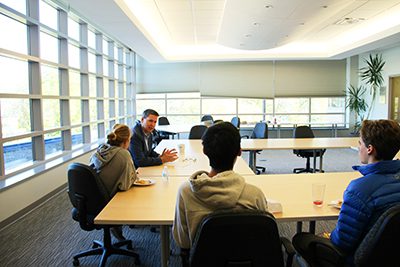October 25, 2018
 by Dr. Bill Hudson, Head of School
by Dr. Bill Hudson, Head of School
Every fall, I invite seniors to have lunch with me in small groups of eight to 10. It is a fantastic time to check in with them about how their senior year is going, learn what their plans are for next year, solicit their feedback on my leadership, and thank them for serving as leaders and role models. I also ask them to share their “MPA moment”–the moment, memory, or experience that captures or illustrates the MPA mission to them. I enjoy hearing their stories and it only deepens my love and appreciation for this amazing community.
A common MPA moment I hear often has to do with their experience of a PreK-12 school under one roof. Seniors will talk about what it was like for them to have an Upper School buddy when they were in Lower School or how much they enjoy now the “pairing assemblies,” when as seniors, they are matched with younger students. Their eyes light up with joy as they share the special relationship they have developed.
I have been a head of school of a high school, a principal of a school with grades 7-12, and taught at a middle school. Because of those experiences, it is easy for me to talk about the difference and the advantage of a PreK-12 school. There is truly something magical about the school climate and culture at MPA that I have not experienced in other schools. The younger students look up to the older students and pick up on the cues unconsciously sent by older students. Older students learn to measure their behavior, knowing that the little ones are watching, and know they are looked up to as role models.
We have several traditions that build this positive school culture. The pairing assemblies are a long-standing tradition, as is next week’s Halloween Parade (read more). Middle and Upper School students line both sides of the hallway, giving high fives as the Lower School students proudly parade in their costumes. As the end of the year, a similar tradition takes place as seniors process through a gauntlet of Middle and Lower school students in their graduation caps and gowns. Throughout the year, there are many other informal experiences, such as kindergarten students walking single file through the Upper School on their way to the Lansing Sports Center, that foster the positive school culture we enjoy at MPA.
According to Human Synergistics International, a corporate consulting group, “Culture is the collection of deeply held beliefs and assumptions that drives behavior within organizations or groups of people. It’s why we do what we do in different situations—culture is how you are expected to behave and comes from shared beliefs through common learning. Ideally these ‘unwritten rules’ correspond to the stated values and beliefs of the organization.” At MPA, unwritten rules such as mutual respect, intellectual curiosity, nurturing relationships, open discourse, and joyful learning are implicitly conveyed in the day-to-day life of a MPA student.
There is ample research that demonstrates the role of a strong school culture in supporting academic achievement. While MPA is not perfect, students have the freedom to focus on their students, develop relationships with their teachers, successfully navigate social interactions with other students without the added stress and resulting anxiety that often accompanies poor school culture. Teachers also benefit from a positive school culture in that it allows them to dig deeper into a topic or explore a concept more fully.
I am proud of our senior class and look forward to a great year with them. There are times when the challenges facing our world and society weigh me down and I find myself worrying about the future. In those moments, I draw inspiration from the hopes and dreams of our students and their commitment to making our world a better place.